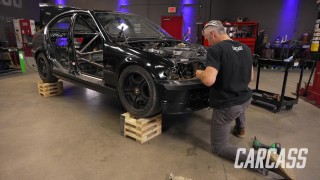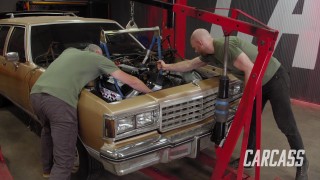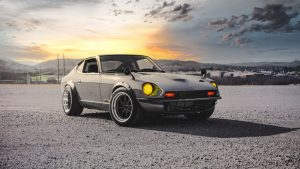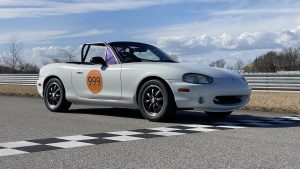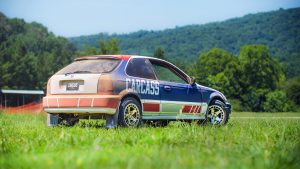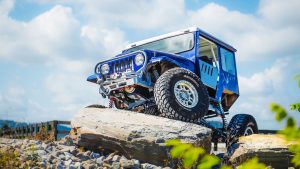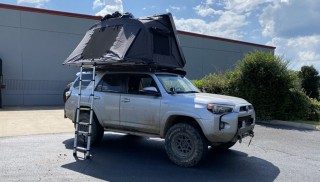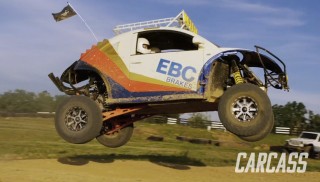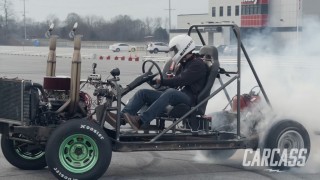More Drifting Trailblazer SS Episodes
Carcass Featured Projects
Carcass Builds
Want more content like this?
Join the PowerNation Email NewsletterParts Used In This Episode
American Powertrain Systems
Tremec Magnum 6-Speed Manual Transmission
Matco Tools
MATCO Tools are the Official Tool Supplier to PowerNation
The Industrial Depot
Tools, Hardware, Shop Supplies
Tom Wood's Custom Drive Shafts
Custom Driveshaft
Episode Transcript
(Jeremy)>> You're watching Powernation!
(Jeremy)>> Today on Carcass we pack our drifting Trailblazer SS with some fresh ponies.
(Jimmy)>> And we transform our plain black exterior into one that fits the bill.
(Jeremy)>> You're watching Carcass.
(Narrator)>> When you want to build something different you turn to Carcass. They transform cars and trucks into one of a kind builds. From street to mud, if you dream it they can build it. This is Carcass, a non-traditional speed shop. [ MUSIC ]
(Jeremy)>> The interior of our four door drifting machine is nearly complete. Now we started with a stock 2006 Trailblazer SS, stripping everything including the seats, the headliner, and even all the trim pieces, lightening the load by about 500 pounds.
(Jimmy)>> Then we got straight to work on the roll cage, building it on top of plinth boxes so we could lower the cage and weld the top sections.
(Jeremy)>> With our jungle gym in place we threw in a quartet of racing seats that we picked up from Summit Racing, and even fabricated some mounts so it could sit level on our wonky floor.
(Jimmy)>> We followed those up with a custom center console and a drifting hand brake that we plumbed to the rear brakes.
(Jeremy)>> Now I did say that our interior is nearly complete. Now we're planning on converting this two wheel drive automatic into a six speed manual. So we're gonna have to do some work inside the cab, but before we can get to that we need to yank out this tired old 400 horsepower pony that nearly has 230,000 miles on it and replace it with a brand new 450 horsepower Clydesdale.
(Jimmy)>> Our starter has arrived.
(Jeremy)>> Let's see it.
(Jimmy)>> This is the Duralast Gold starter that comes with a lifetime warranty. It's engineered to provide the torque that we need to consistently start our Trailblazer and it's built with proprietary components that are made to last.
(Jeremy)>> That's all fine and dandy by why Duralast?
(Jimmy)>> For one thing the Duralast brand got its start with reliable starters and alternators. So that's why we're going with a starter for a performance vehicle like our Trailblazer, but there's more than just starters and alternators. They also offer other stuff like brakes, chassis parts, and engine management parts that share the same Duralast reliability.
(Jeremy)>> Well I am sold. What do you say we slap this thing on our engine and drop it in the Trailblazer?
(Jimmy)>> Let's do it. With our new Duralast starter installed this puppy is ready to go, but before it can even budge this old worn out engine has to go.
(Jeremy)>> And to make things easier for ourselves we're gonna remove the hood and set it aside along with our American bow tie grille because we plan to disassemble most of this front end. There's not much holding that guy on there. Holy cow, I don't want to break it but it's half broke already. I got mine. This is like aftermarket.
(Jimmy)>> No these are o-e fasteners I think. Cost you $74 dollars from the dealer to replace them.
(Jeremy)>> Everything in front of our engine has to go. This includes the trans cooler and the radiator.
(Jimmy)>> It also calls for the fan, which we remove with a hefty wrench and a dead blow allowing us to tackle the front accessory drive next.
(Jeremy)>> You know we've got a couple more things to pull off the top. Then we'll go underneath.
(Jimmy)>> Yeah I think we get to the point where the intake's off and then we'll be good.
(Jeremy)>> With a few bolts here and a few hoses there we'll have the intake free from the top of the engine, making plenty of room for us to pull this poor pony free.
(Jimmy)>> But the engine isn't ready to come out yet. It's still attached to the exhaust. We need to remove the driveshaft and we need to drop the automatic transmission because we won't be needing it anymore.
(Jeremy)>> With our motor mounts loose we can now yank out this washed up race horse. All that leg work we put into prepping the front end, well it's about to pay off, making easy work lifting this 400 pound engine free from its home. That's old and tired.
(Jimmy)>> Yeah but the work doesn't stop here. There are a few things we need to transfer over from the old engine onto the new engine that we got from Powertrain Products. Things like the oil pan and pickup tube are removed and cleaned up before they're added to the bottom of our new power plant. Both these and the engine mounts are specific to our Trailblazer and will allow us to easily drop in our engine.
(Jeremy)>> To finish prepping the engine for install we'll have to throw in the coolant temp sensor and the oil pressure sensor, leaving us only one thing to do.
(Jimmy)>> Giddy up ponies! Alright dude!
(Jeremy)>> Put her in dude, lower it down. Alright we can back up like three inches maybe? Keep going, stop, and then go down. You can go down quite a ways actually. We're not crazy far off here.
(Jimmy)>> We caught on something?
(Jeremy)>> I think we're caught on that side.
(Jimmy)>> There it goes.
(Jeremy)>> A little more. I'm on on this side. Our engine is set in place but there's still a couple of things we need to do like swap over our headers, we need to bolt the intake down, and hook up the exhaust.
(Jimmy)>> We also have to install the alternator, clean up the wiring, and hook up the fuel system.
(Jeremy)>> What do you say we just knock that all out?
(Jimmy)>> Let's do it.
(Jeremy)>> We'll snug up our engine for starters, and then we'll slip in our headers from below and bolt them in up top.
(Jimmy)>> We'll move to the intake next, bolting it down to the heads and connecting the fuel line.
(Jeremy)>> The coil packs get added, bolting them in place, and connecting them to the power source.
(Jimmy)>> This is followed by a mess of wiring that we need to clean up. There are a lot of connections to be made. Things like the injectors and the maf sensors if I had to name a few.
(Jeremy)>> With most of the wiring out of the way we can tackle the front accessory drive. An alternator gets thrown into the mix and a final connection can be made. Hey Jimmy come check this out. I was walking down by the dock door and I saw that Powertrain Products had sent in one of their front differentials for GM trucks and s-u-v's. Now the cool thing about this is that they do a really good job upgrading the o-e parts inside of here that create common issues like noise and wear. Take this for instance, the upgraded parts they put inside of here help decrease bearing wear and pinion failure.
(Jimmy)>> So they actually put new internals in these things?
(Jeremy)>> I was doing a little research on this and it looks like Powertrain Products installs new stub shafts and axle tubes with new bearings, and the best thing about this is this whole thing is backed by a 7 year warranty.
(Jimmy)>> Well it's too bad our Trailblazer is two wheel drive otherwise we could use this in our build. Up next we're shifting into high gear adding a new trans and a few personalized goodies.
(Jimmy)>> With a brand new 450 horsepower engine sitting under the hood our Trailblazer SS is taking on a new persona.
(Jeremy)>> That's right, we'll soon be able to call this thing a drifting Trailblazer with the thoroughbred we have up front, but before we get to that point we need to saddle up this pony.
(Jimmy)>> That means we need to install a transmission. Now we're not going to be using the stock transmission that the Trailblazer came with. We're opting for a Tremec Magnum 6 speed manual transmission from American Powertrain. Not only will this up the fun factor but it'll help us maintain the r-p-m range that we want to operate in.
(Jeremy)>> To make this install easier we'll work on this vehicle when it's on the hoist. Jimmy and I will both tackle the clutch together because four hands are way better than two.
(Jimmy)>> We'll start by threading two bolts to secure the clutch pressure plate. Then feed in the provided clutch disc alignment pin.
(Jeremy)>> With the pressure plate in alignment we'll add the four remaining bolts making sure to snug them up by hand. Then we'll torque them down in a criss cross pattern to 52 foot pounds and make sure we remove the alignment pin when we're done.
(Jimmy)>> In order to setup our clutch throw out bearing spacing we need to install the bell housing and take a measurement. Using a square we'll use the face of the bell housing for reference and measure to the fingers of the pressure plate with a caliper.
(Jeremy)>> On the transmission we'll use a square and set it on the throw out bearing, measuring the distance from the throw out bearing to where the transmission case would meet the bell housing. With those numbers in hand we'll do a little math and our goal is to have about 150 thousandths air gap.
(Jimmy)>> To achieve this we'll pop the throw out bearing off the shaft, and we'll need to add five 90 thousandths shims. Then we can slip the throw out bearing back on the shaft.
(Jeremy)>> Our transmission is now ready to be installed but before we can do that we need to make some changes in the cab to make room for our shifter, and that all starts with the measurement of the transmission.
(Jimmy)>> 23 inches. Using the bell housing for reference again we can mark the location on the underside of the vehicle and drill a pilot hole to reference the location on the other side.
(Jeremy)>> In the cab we'll unbolt and remove the old automatic shifter. [ MUSIC ] And using the pilot hole we drilled from the bottom we'll line up a four inch hole saw and plunge cut a giant hole through the transmission tunnel.
(Jimmy)>> Think we can get it first try?
(Jeremy)>> I don't know. Let's see if we can put all six of these speeds up there. Probably only use like one or two, maybe three. This is a speed demon is what this is. Second gear, second gear! [ MUSIC ]
(Jimmy)>> Go forward a little bit.
(Jeremy)>> I guess that's it. [ MUSIC ] And stop. Now we've got a shifter it's gonna hit. So we're gonna have to really...
(Jimmy)>> Installing the transmission is pretty straight forward. We need to marry the input shaft of the transmission with the clutch, carefully guiding this 135 pound beast into position.
(Jeremy)>> Now it may be tempting to use the bolts to suck in the transmission but you can cause a lot of damage if you do this prematurely. You should only use the bolts when the transmission meets the bell housing.
(Jimmy)>> To finish up our installation we'll use the stock cross member and bushings, snugging everything up.
(Jeremy)>> Now it's time to get started on our clutch pedal. To get it installed we'll drill out 2 connecting inch and a half holes in the firewall, checking to make sure that the fittings clear the hole.
(Jimmy)>> Next we'll drill a hole through the bracket we fabbed up and punch it through the floor. Then add the pedal securing it to the bracket. We'll follow that up with a remote reservoir, which will mount in the cab, and connect the hose to the master cylinder.
(Jeremy)>> We'll make the final connection under the vehicle, attaching the clutch line.
(Jimmy)>> The last thing we're gonna work on here is the shifter. We're fabbing up a custom handle bracket to make shifting convenient for the driver and to operate along with using the hand brake. With a few pieces of thick steel we'll weld together an offset piece that will attach to the included handle bracket.
(Jeremy)>> Back in the cab we'll attach the new handle bracket to the shifter before we can figure out a solution for the handle.
(Jimmy)>> This is the last piece.
(Jeremy)>> What's that?
(Jimmy)>> Really big wrench, shifter handle.
(Jeremy)>> No way.
(Jimmy)>> We don't have one. So I figured this would do the trick.
(Jeremy)>> That's gonna work. Oh it's comfy too actually. Jimmy's got a great idea for the handle. We're gonna cut up this huge inch and five-sixteenths wrench and weld it to the handle bracket. Then we'll just put it in the cab and see how it acts. This worked out really, really good but can you imagine it as a right hand drive car?
(Jimmy)>> I don't really have any coordination with my left hand.
(Jeremy)>> I got plenty on this side. Dump the clutch ready, one, two, three. [ making engine noises ]
(Jimmy)>> Coming up look out EPA.
(Jeremy)>> Because we're transforming the exterior of our Trailblazer SS.
(Jimmy)>> That's right, we're making a carbon hood print.
(Jeremy)>> We've made a ton of improvements on our 2006 Trailblazer SS. From stripping the interior to constructing a roll cage we lightened the load.
(Jimmy)>> But we've added some weight back into this family size power house with some racing seats, a custom center console, a hand brake, and a shifter that suits mine and Jeremy's personalities.
(Jeremy)>> Yeah and with our interior finished and our powertrain nearly complete we figured the exterior should get a little tender love and care.
(Jimmy)>> This 14 year old paint job is in decent shape and we could polish this truck up to a mirror like shine but we have alternative plans for this guy.
(Jeremy)>> Our vehicle is gonna get some special treatment from the guys down the street, making our Trailblazer look like a true drifting vehicle. This process starts with some design ideas. Finding out the colors we like and the ones we don't. When we've chosen the design we'll send it off to The Wrap Lab in Franklin, Tennessee, and let the pros get to work. They prep the vehicle. Then they take high resolution vinyl print outs with adhesive backings and they carefully apply them to the correct areas on the vehicle. Using special squeegeeing techniques they eliminate all the bubbles on the wrap. It's a challenging process, and like anything it takes practice to get really good at it.
(Jimmy)>> That's why we're leaving it up to the professionals to do the job, but while we wait for the exterior of our vehicle to transform we're gonna work on a little Carcass transformation of our own. [ MUSIC ] We're gonna reconstruct the hood of our Trailblazer SS but we're gonna do it with carbon fiber.
(Jeremy)>> Carbon fiber can be up to five times stronger than steel and twice as stiff, but for our application we aren't concerned about strength. We're concerned about weight savings and the looks department.
(Jimmy)>> To get our hood looking sporty there's a little prep involved. Carbon fiber is laid down in layers molding to the shape of the hood. So with a thorough cleaning we can start the process.
(Jeremy)>> We'll then apply several coats of wax making sure to gently buff it after each coat. With a good layer of this stuff on we won't have to worry about the carbon fiber sticking to the hood.
(Jimmy)>> With that out of the way we can start working with the material. We're pre-cutting four sections of carbon fiber cloth to size. We're doing this because this will be a fairly quick process and having these on standby will prevent headaches down the road.
(Jeremy)>> We're now ready to lay down our first layer. Spreading it out on the hood we'll use a can of adhesive spray to help hold it in place.
(Jimmy)>> Then we can start mixing the laminating epoxy resin. This is mixed three to one with a hardener. Two part epoxies like this have something called a pot life. This means there's only an effective working time before it becomes less workable or useless and you risk wasting material. The pot life on this epoxy is one hour. So we're gonna have to work quickly to get each layer on.
(Jeremy)>> We're using a squeegee to carefully spread the epoxy covering every square inch of carbon fiber. We'll lay it on thick getting good coverage, and then we'll go over it one more time to remove any excess.
(Jimmy)>> This is repeated again with the second layer, and again with the third, and once more for our final layer of carbon fiber letting the epoxy cure overnight. I think we got it, Johnny on the spot. Good job man.
(Jeremy)>> This thing looks amazing and I can't believe how well it turned out and how easy it was to do. With a grand total of about two hours of labor into it we can't wait to separate it from the steel hood and see the fruits of our labor.
(Jimmy)>> The epoxy has been given ample time to cure and it's time to crack it loose from the mold.
(Jeremy)>> This is why several coats of wax are essential to this process.
(Jimmy)>> Whoa, that's awesome! Seeing the underside of the hood I'm happy to say that our prep work has paid off, but we're not done yet. We need to make the top side of this thing look just as glassy smooth as the bottom side.
(Jeremy)>> This starts with a little scuff sanding. We're using 120 grit to prep for our flow coat.
(Jimmy)>> We're laying on this coat super thick using modified squeegees to spread but allowing it to pool. We'll let gravity do the work of leveling it all out.
(Jeremy)>> With our flow coat having ample time to cure we'll hit it one more time with a d-a and a series of sand paper grits.
(Jimmy)>> Then we'll trim the edges with a cutoff wheel taking care not to over cut. We were lucky that the underside of the mold left a line to follow which corresponds with the edge of the hood.
(Jeremy)>> The last step to this process is to give our carbon fiber hood some u/v protection with a clear coat and we'll let that dry overnight.
(Jimmy)>> Up next an exterior transformation you won't want to miss. This is Carcass!
[ MUSIC ]
(Jimmy)>> Our carbon fiber hood came out pretty good.
(Jeremy)>> Not bad for a couple of guys who have no idea what they're doing.
(Jimmy)>> It's not a super tough process but it's one of these things where every step of the way is another opportunity to completely screw it up and luckily Uncle Murphy stayed home today.
(Jeremy)>> Isn't that the guy who says what can go wrong will go wrong?
(Jimmy)>> Yeah.
(Jeremy)>> Well our carbon fiber hood looks amazing and I can't wait to see it paired up with our newly wrapped Trailblazer.
(Jimmy)>> Let's throw it on.
(Jeremy)>> To mount our hood we need to add a few reinforcements to help hold the hood in place. At the break we'll take two pieces of 20 gauge steel and bend them length wise at 90 degrees.
(Jimmy)>> With those in hand we'll shrink one side and test fit them to make sure they fit the contour of the hood. Then at the band saw we'll cut one of them down the middle removing a chunk so that they'll be able to form an "X" on the hood.
(Jeremy)>> We'll need to trace the metal stiffeners and use those marks to scuff the surface. Then we'll apply some panel bond adhesive and stick are metal reinforcements to the bottom side of the hood.
(Jimmy)>> To finish up this install we'll drill some holes for a hood pin kit we picked up from Summit Racing, installing the plates that prevent the pins from scratching the hood. [ MUSIC ] Dude this thing looks way more like a race car now.
(Jeremy)>> It looks just like the original hood but it's way cooler.
(Jimmy)>> Our design team the guys at The Wrap Lab really knocked this thing out of the park, and to be honest I'm kinda speechless.
(Jeremy)>> We've got black body lines meeting orange wrap lines. We've got killer looking side stripes, our signature lightning bolt, and Carcass logo written on the back, and that's paired up with our custom carbon fiber hood, and that gives our drifting Trailblazer a whole new persona, but our wheels could use some attention. Fortunately we plan on slapping on some nice, new, shiny ones but if we were gonna be running our stock wheels our go to product would be Sonax's Wheel Cleaner Plus to restore them to their like new shine.
(Jimmy)>> This stuff can be used on all steel, alloy, chrome, and polished wheels, removing brake dust and those stubborn dirt spots you can never seem to get out. The Wheel Cleaner Plus is a fast acting powerful wheel cleaner that has an acid free formula that safe to use on clear coats and won't corrode lug nuts. We need to drive this thing.
(Jeremy)>> We can't. We don't have a driveshaft yet and we haven't even heard this thing run.
(Jimmy)>> Well let's get cranking on then.
(Jeremy)>> There's not too much we need to do before we can break in our new engine and transmission. We'll throw in a special order driveshaft we got from our friends at Tom Woods Custom Driveshafts, who's always quick on delivery. Then we'll just add some fluids and prep the engine for startup.
(Jimmy)>> Alright!
(Jeremy)>> That's exactly what it was supposed to do.
(Jimmy)>> It sounds good too. Got a little rumble to it.
(Jeremy)>> I like that! That was simple, very simple.
(Jimmy)>> It's just a matter of swapping everything that was on the old engine to the new one cause it's based on the same platform.
(Jeremy)>> This is amazing! It purrs like a kitten.
(Jimmy)>> I can't wait to see how this thing performs.
(Jeremy)>> You know what we need to do though? We need to put that killer hood on here and go drive it because I want to know what it's like to drive a Trailblazer with a 6 speed.
(Jimmy)>> We did something pretty cool here.
(Jeremy)>> It's gonna be so crazy! Let's go get the hood. [ MUSIC ]
(Jimmy)>> Follow along with this build at Powernation TV dot com.
(Jeremy)>> Next time on Carcass Jimmy and I get a special lesson in drifting from Duralast Pro drifter Josh Robinson.
(Jimmy)>> Plus we make some major upgrades to our steering and suspension. Catch us next time on Carcass.
Show Full Transcript
(Jeremy)>> Today on Carcass we pack our drifting Trailblazer SS with some fresh ponies.
(Jimmy)>> And we transform our plain black exterior into one that fits the bill.
(Jeremy)>> You're watching Carcass.
(Narrator)>> When you want to build something different you turn to Carcass. They transform cars and trucks into one of a kind builds. From street to mud, if you dream it they can build it. This is Carcass, a non-traditional speed shop. [ MUSIC ]
(Jeremy)>> The interior of our four door drifting machine is nearly complete. Now we started with a stock 2006 Trailblazer SS, stripping everything including the seats, the headliner, and even all the trim pieces, lightening the load by about 500 pounds.
(Jimmy)>> Then we got straight to work on the roll cage, building it on top of plinth boxes so we could lower the cage and weld the top sections.
(Jeremy)>> With our jungle gym in place we threw in a quartet of racing seats that we picked up from Summit Racing, and even fabricated some mounts so it could sit level on our wonky floor.
(Jimmy)>> We followed those up with a custom center console and a drifting hand brake that we plumbed to the rear brakes.
(Jeremy)>> Now I did say that our interior is nearly complete. Now we're planning on converting this two wheel drive automatic into a six speed manual. So we're gonna have to do some work inside the cab, but before we can get to that we need to yank out this tired old 400 horsepower pony that nearly has 230,000 miles on it and replace it with a brand new 450 horsepower Clydesdale.
(Jimmy)>> Our starter has arrived.
(Jeremy)>> Let's see it.
(Jimmy)>> This is the Duralast Gold starter that comes with a lifetime warranty. It's engineered to provide the torque that we need to consistently start our Trailblazer and it's built with proprietary components that are made to last.
(Jeremy)>> That's all fine and dandy by why Duralast?
(Jimmy)>> For one thing the Duralast brand got its start with reliable starters and alternators. So that's why we're going with a starter for a performance vehicle like our Trailblazer, but there's more than just starters and alternators. They also offer other stuff like brakes, chassis parts, and engine management parts that share the same Duralast reliability.
(Jeremy)>> Well I am sold. What do you say we slap this thing on our engine and drop it in the Trailblazer?
(Jimmy)>> Let's do it. With our new Duralast starter installed this puppy is ready to go, but before it can even budge this old worn out engine has to go.
(Jeremy)>> And to make things easier for ourselves we're gonna remove the hood and set it aside along with our American bow tie grille because we plan to disassemble most of this front end. There's not much holding that guy on there. Holy cow, I don't want to break it but it's half broke already. I got mine. This is like aftermarket.
(Jimmy)>> No these are o-e fasteners I think. Cost you $74 dollars from the dealer to replace them.
(Jeremy)>> Everything in front of our engine has to go. This includes the trans cooler and the radiator.
(Jimmy)>> It also calls for the fan, which we remove with a hefty wrench and a dead blow allowing us to tackle the front accessory drive next.
(Jeremy)>> You know we've got a couple more things to pull off the top. Then we'll go underneath.
(Jimmy)>> Yeah I think we get to the point where the intake's off and then we'll be good.
(Jeremy)>> With a few bolts here and a few hoses there we'll have the intake free from the top of the engine, making plenty of room for us to pull this poor pony free.
(Jimmy)>> But the engine isn't ready to come out yet. It's still attached to the exhaust. We need to remove the driveshaft and we need to drop the automatic transmission because we won't be needing it anymore.
(Jeremy)>> With our motor mounts loose we can now yank out this washed up race horse. All that leg work we put into prepping the front end, well it's about to pay off, making easy work lifting this 400 pound engine free from its home. That's old and tired.
(Jimmy)>> Yeah but the work doesn't stop here. There are a few things we need to transfer over from the old engine onto the new engine that we got from Powertrain Products. Things like the oil pan and pickup tube are removed and cleaned up before they're added to the bottom of our new power plant. Both these and the engine mounts are specific to our Trailblazer and will allow us to easily drop in our engine.
(Jeremy)>> To finish prepping the engine for install we'll have to throw in the coolant temp sensor and the oil pressure sensor, leaving us only one thing to do.
(Jimmy)>> Giddy up ponies! Alright dude!
(Jeremy)>> Put her in dude, lower it down. Alright we can back up like three inches maybe? Keep going, stop, and then go down. You can go down quite a ways actually. We're not crazy far off here.
(Jimmy)>> We caught on something?
(Jeremy)>> I think we're caught on that side.
(Jimmy)>> There it goes.
(Jeremy)>> A little more. I'm on on this side. Our engine is set in place but there's still a couple of things we need to do like swap over our headers, we need to bolt the intake down, and hook up the exhaust.
(Jimmy)>> We also have to install the alternator, clean up the wiring, and hook up the fuel system.
(Jeremy)>> What do you say we just knock that all out?
(Jimmy)>> Let's do it.
(Jeremy)>> We'll snug up our engine for starters, and then we'll slip in our headers from below and bolt them in up top.
(Jimmy)>> We'll move to the intake next, bolting it down to the heads and connecting the fuel line.
(Jeremy)>> The coil packs get added, bolting them in place, and connecting them to the power source.
(Jimmy)>> This is followed by a mess of wiring that we need to clean up. There are a lot of connections to be made. Things like the injectors and the maf sensors if I had to name a few.
(Jeremy)>> With most of the wiring out of the way we can tackle the front accessory drive. An alternator gets thrown into the mix and a final connection can be made. Hey Jimmy come check this out. I was walking down by the dock door and I saw that Powertrain Products had sent in one of their front differentials for GM trucks and s-u-v's. Now the cool thing about this is that they do a really good job upgrading the o-e parts inside of here that create common issues like noise and wear. Take this for instance, the upgraded parts they put inside of here help decrease bearing wear and pinion failure.
(Jimmy)>> So they actually put new internals in these things?
(Jeremy)>> I was doing a little research on this and it looks like Powertrain Products installs new stub shafts and axle tubes with new bearings, and the best thing about this is this whole thing is backed by a 7 year warranty.
(Jimmy)>> Well it's too bad our Trailblazer is two wheel drive otherwise we could use this in our build. Up next we're shifting into high gear adding a new trans and a few personalized goodies.
(Jimmy)>> With a brand new 450 horsepower engine sitting under the hood our Trailblazer SS is taking on a new persona.
(Jeremy)>> That's right, we'll soon be able to call this thing a drifting Trailblazer with the thoroughbred we have up front, but before we get to that point we need to saddle up this pony.
(Jimmy)>> That means we need to install a transmission. Now we're not going to be using the stock transmission that the Trailblazer came with. We're opting for a Tremec Magnum 6 speed manual transmission from American Powertrain. Not only will this up the fun factor but it'll help us maintain the r-p-m range that we want to operate in.
(Jeremy)>> To make this install easier we'll work on this vehicle when it's on the hoist. Jimmy and I will both tackle the clutch together because four hands are way better than two.
(Jimmy)>> We'll start by threading two bolts to secure the clutch pressure plate. Then feed in the provided clutch disc alignment pin.
(Jeremy)>> With the pressure plate in alignment we'll add the four remaining bolts making sure to snug them up by hand. Then we'll torque them down in a criss cross pattern to 52 foot pounds and make sure we remove the alignment pin when we're done.
(Jimmy)>> In order to setup our clutch throw out bearing spacing we need to install the bell housing and take a measurement. Using a square we'll use the face of the bell housing for reference and measure to the fingers of the pressure plate with a caliper.
(Jeremy)>> On the transmission we'll use a square and set it on the throw out bearing, measuring the distance from the throw out bearing to where the transmission case would meet the bell housing. With those numbers in hand we'll do a little math and our goal is to have about 150 thousandths air gap.
(Jimmy)>> To achieve this we'll pop the throw out bearing off the shaft, and we'll need to add five 90 thousandths shims. Then we can slip the throw out bearing back on the shaft.
(Jeremy)>> Our transmission is now ready to be installed but before we can do that we need to make some changes in the cab to make room for our shifter, and that all starts with the measurement of the transmission.
(Jimmy)>> 23 inches. Using the bell housing for reference again we can mark the location on the underside of the vehicle and drill a pilot hole to reference the location on the other side.
(Jeremy)>> In the cab we'll unbolt and remove the old automatic shifter. [ MUSIC ] And using the pilot hole we drilled from the bottom we'll line up a four inch hole saw and plunge cut a giant hole through the transmission tunnel.
(Jimmy)>> Think we can get it first try?
(Jeremy)>> I don't know. Let's see if we can put all six of these speeds up there. Probably only use like one or two, maybe three. This is a speed demon is what this is. Second gear, second gear! [ MUSIC ]
(Jimmy)>> Go forward a little bit.
(Jeremy)>> I guess that's it. [ MUSIC ] And stop. Now we've got a shifter it's gonna hit. So we're gonna have to really...
(Jimmy)>> Installing the transmission is pretty straight forward. We need to marry the input shaft of the transmission with the clutch, carefully guiding this 135 pound beast into position.
(Jeremy)>> Now it may be tempting to use the bolts to suck in the transmission but you can cause a lot of damage if you do this prematurely. You should only use the bolts when the transmission meets the bell housing.
(Jimmy)>> To finish up our installation we'll use the stock cross member and bushings, snugging everything up.
(Jeremy)>> Now it's time to get started on our clutch pedal. To get it installed we'll drill out 2 connecting inch and a half holes in the firewall, checking to make sure that the fittings clear the hole.
(Jimmy)>> Next we'll drill a hole through the bracket we fabbed up and punch it through the floor. Then add the pedal securing it to the bracket. We'll follow that up with a remote reservoir, which will mount in the cab, and connect the hose to the master cylinder.
(Jeremy)>> We'll make the final connection under the vehicle, attaching the clutch line.
(Jimmy)>> The last thing we're gonna work on here is the shifter. We're fabbing up a custom handle bracket to make shifting convenient for the driver and to operate along with using the hand brake. With a few pieces of thick steel we'll weld together an offset piece that will attach to the included handle bracket.
(Jeremy)>> Back in the cab we'll attach the new handle bracket to the shifter before we can figure out a solution for the handle.
(Jimmy)>> This is the last piece.
(Jeremy)>> What's that?
(Jimmy)>> Really big wrench, shifter handle.
(Jeremy)>> No way.
(Jimmy)>> We don't have one. So I figured this would do the trick.
(Jeremy)>> That's gonna work. Oh it's comfy too actually. Jimmy's got a great idea for the handle. We're gonna cut up this huge inch and five-sixteenths wrench and weld it to the handle bracket. Then we'll just put it in the cab and see how it acts. This worked out really, really good but can you imagine it as a right hand drive car?
(Jimmy)>> I don't really have any coordination with my left hand.
(Jeremy)>> I got plenty on this side. Dump the clutch ready, one, two, three. [ making engine noises ]
(Jimmy)>> Coming up look out EPA.
(Jeremy)>> Because we're transforming the exterior of our Trailblazer SS.
(Jimmy)>> That's right, we're making a carbon hood print.
(Jeremy)>> We've made a ton of improvements on our 2006 Trailblazer SS. From stripping the interior to constructing a roll cage we lightened the load.
(Jimmy)>> But we've added some weight back into this family size power house with some racing seats, a custom center console, a hand brake, and a shifter that suits mine and Jeremy's personalities.
(Jeremy)>> Yeah and with our interior finished and our powertrain nearly complete we figured the exterior should get a little tender love and care.
(Jimmy)>> This 14 year old paint job is in decent shape and we could polish this truck up to a mirror like shine but we have alternative plans for this guy.
(Jeremy)>> Our vehicle is gonna get some special treatment from the guys down the street, making our Trailblazer look like a true drifting vehicle. This process starts with some design ideas. Finding out the colors we like and the ones we don't. When we've chosen the design we'll send it off to The Wrap Lab in Franklin, Tennessee, and let the pros get to work. They prep the vehicle. Then they take high resolution vinyl print outs with adhesive backings and they carefully apply them to the correct areas on the vehicle. Using special squeegeeing techniques they eliminate all the bubbles on the wrap. It's a challenging process, and like anything it takes practice to get really good at it.
(Jimmy)>> That's why we're leaving it up to the professionals to do the job, but while we wait for the exterior of our vehicle to transform we're gonna work on a little Carcass transformation of our own. [ MUSIC ] We're gonna reconstruct the hood of our Trailblazer SS but we're gonna do it with carbon fiber.
(Jeremy)>> Carbon fiber can be up to five times stronger than steel and twice as stiff, but for our application we aren't concerned about strength. We're concerned about weight savings and the looks department.
(Jimmy)>> To get our hood looking sporty there's a little prep involved. Carbon fiber is laid down in layers molding to the shape of the hood. So with a thorough cleaning we can start the process.
(Jeremy)>> We'll then apply several coats of wax making sure to gently buff it after each coat. With a good layer of this stuff on we won't have to worry about the carbon fiber sticking to the hood.
(Jimmy)>> With that out of the way we can start working with the material. We're pre-cutting four sections of carbon fiber cloth to size. We're doing this because this will be a fairly quick process and having these on standby will prevent headaches down the road.
(Jeremy)>> We're now ready to lay down our first layer. Spreading it out on the hood we'll use a can of adhesive spray to help hold it in place.
(Jimmy)>> Then we can start mixing the laminating epoxy resin. This is mixed three to one with a hardener. Two part epoxies like this have something called a pot life. This means there's only an effective working time before it becomes less workable or useless and you risk wasting material. The pot life on this epoxy is one hour. So we're gonna have to work quickly to get each layer on.
(Jeremy)>> We're using a squeegee to carefully spread the epoxy covering every square inch of carbon fiber. We'll lay it on thick getting good coverage, and then we'll go over it one more time to remove any excess.
(Jimmy)>> This is repeated again with the second layer, and again with the third, and once more for our final layer of carbon fiber letting the epoxy cure overnight. I think we got it, Johnny on the spot. Good job man.
(Jeremy)>> This thing looks amazing and I can't believe how well it turned out and how easy it was to do. With a grand total of about two hours of labor into it we can't wait to separate it from the steel hood and see the fruits of our labor.
(Jimmy)>> The epoxy has been given ample time to cure and it's time to crack it loose from the mold.
(Jeremy)>> This is why several coats of wax are essential to this process.
(Jimmy)>> Whoa, that's awesome! Seeing the underside of the hood I'm happy to say that our prep work has paid off, but we're not done yet. We need to make the top side of this thing look just as glassy smooth as the bottom side.
(Jeremy)>> This starts with a little scuff sanding. We're using 120 grit to prep for our flow coat.
(Jimmy)>> We're laying on this coat super thick using modified squeegees to spread but allowing it to pool. We'll let gravity do the work of leveling it all out.
(Jeremy)>> With our flow coat having ample time to cure we'll hit it one more time with a d-a and a series of sand paper grits.
(Jimmy)>> Then we'll trim the edges with a cutoff wheel taking care not to over cut. We were lucky that the underside of the mold left a line to follow which corresponds with the edge of the hood.
(Jeremy)>> The last step to this process is to give our carbon fiber hood some u/v protection with a clear coat and we'll let that dry overnight.
(Jimmy)>> Up next an exterior transformation you won't want to miss. This is Carcass!
[ MUSIC ]
(Jimmy)>> Our carbon fiber hood came out pretty good.
(Jeremy)>> Not bad for a couple of guys who have no idea what they're doing.
(Jimmy)>> It's not a super tough process but it's one of these things where every step of the way is another opportunity to completely screw it up and luckily Uncle Murphy stayed home today.
(Jeremy)>> Isn't that the guy who says what can go wrong will go wrong?
(Jimmy)>> Yeah.
(Jeremy)>> Well our carbon fiber hood looks amazing and I can't wait to see it paired up with our newly wrapped Trailblazer.
(Jimmy)>> Let's throw it on.
(Jeremy)>> To mount our hood we need to add a few reinforcements to help hold the hood in place. At the break we'll take two pieces of 20 gauge steel and bend them length wise at 90 degrees.
(Jimmy)>> With those in hand we'll shrink one side and test fit them to make sure they fit the contour of the hood. Then at the band saw we'll cut one of them down the middle removing a chunk so that they'll be able to form an "X" on the hood.
(Jeremy)>> We'll need to trace the metal stiffeners and use those marks to scuff the surface. Then we'll apply some panel bond adhesive and stick are metal reinforcements to the bottom side of the hood.
(Jimmy)>> To finish up this install we'll drill some holes for a hood pin kit we picked up from Summit Racing, installing the plates that prevent the pins from scratching the hood. [ MUSIC ] Dude this thing looks way more like a race car now.
(Jeremy)>> It looks just like the original hood but it's way cooler.
(Jimmy)>> Our design team the guys at The Wrap Lab really knocked this thing out of the park, and to be honest I'm kinda speechless.
(Jeremy)>> We've got black body lines meeting orange wrap lines. We've got killer looking side stripes, our signature lightning bolt, and Carcass logo written on the back, and that's paired up with our custom carbon fiber hood, and that gives our drifting Trailblazer a whole new persona, but our wheels could use some attention. Fortunately we plan on slapping on some nice, new, shiny ones but if we were gonna be running our stock wheels our go to product would be Sonax's Wheel Cleaner Plus to restore them to their like new shine.
(Jimmy)>> This stuff can be used on all steel, alloy, chrome, and polished wheels, removing brake dust and those stubborn dirt spots you can never seem to get out. The Wheel Cleaner Plus is a fast acting powerful wheel cleaner that has an acid free formula that safe to use on clear coats and won't corrode lug nuts. We need to drive this thing.
(Jeremy)>> We can't. We don't have a driveshaft yet and we haven't even heard this thing run.
(Jimmy)>> Well let's get cranking on then.
(Jeremy)>> There's not too much we need to do before we can break in our new engine and transmission. We'll throw in a special order driveshaft we got from our friends at Tom Woods Custom Driveshafts, who's always quick on delivery. Then we'll just add some fluids and prep the engine for startup.
(Jimmy)>> Alright!
(Jeremy)>> That's exactly what it was supposed to do.
(Jimmy)>> It sounds good too. Got a little rumble to it.
(Jeremy)>> I like that! That was simple, very simple.
(Jimmy)>> It's just a matter of swapping everything that was on the old engine to the new one cause it's based on the same platform.
(Jeremy)>> This is amazing! It purrs like a kitten.
(Jimmy)>> I can't wait to see how this thing performs.
(Jeremy)>> You know what we need to do though? We need to put that killer hood on here and go drive it because I want to know what it's like to drive a Trailblazer with a 6 speed.
(Jimmy)>> We did something pretty cool here.
(Jeremy)>> It's gonna be so crazy! Let's go get the hood. [ MUSIC ]
(Jimmy)>> Follow along with this build at Powernation TV dot com.
(Jeremy)>> Next time on Carcass Jimmy and I get a special lesson in drifting from Duralast Pro drifter Josh Robinson.
(Jimmy)>> Plus we make some major upgrades to our steering and suspension. Catch us next time on Carcass.







